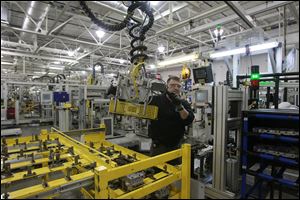
Think tank: Trade pact creates links for products
Toledo’s top partner Toronto, then Calgary
11/9/2013
A photo of an employee at the General Motors Toledo Transmission plant in Toledo. A Brookings Institution study noted that Toledo has developed links to Canadian and Mexican cities largely through auto parts, but also with energy products.
Area residents might not be surprised to learn that one of metro Toledo’s biggest North American trading partners is Toronto, given Toledo’s proximity to Canada.
But how many would guess that the second largest trading partner is Calgary, in the Canadian province of Alberta, or that Toledo’s third largest trading partner is Mexico City?
Those are just a few interesting trade facts revealed in a new study by the Brookings Institution’s Metropolitan Policy Program: Metro North America: Metros as Hubs of Advanced Industries and Integrated Goods Trade.
According to the Washington-based think tank, in the wake of the North American Free Trade Agreement 20 years ago, trade has generated a network of North American cities linked together in order to engage in advanced industrial production and trade.
Trade within North America no longer is characterized by the exchange of finished products. Instead, metro areas in the United States, Canada, and Mexico now work in tandem to complete different stages of production in order to maximize cost efficiency and quality.
The result are products that are North American, rather than country specific, and end up being offered to the rest of the world.
For example, Detroit and Toronto have developed links through automotive products; San Jose, Calif., and Mexico City have links through electronics, and Seattle and Montreal have a relationship through aerospace products.
Toledo, Brookings noted, has developed links to Canadian and Mexican cities largely through auto parts, but also with energy products.
Trade between Toledo and metro areas in Canada and Mexico total $4.8 billion a year — approximately $3.1 billion with Canada and $1.7 billion with Mexico. Trade with those two countries accounts for 37.1 percent of Toledo’s $12.9 billion in total international trade. Of the 100 largest U.S. metro areas, only five rank ahead of Toledo in the percentage of trade occurring within North America.
The study’s authors don’t credit NAFTA with the creation of the metro trade relationships, but they do acknowledge that the controversial agreement “certainly helped facilitate trade and investment within North America.”
NAFTA “took effect amid broader forces that were already shifting firm behavior, and therefore global production and trade patterns,” the study said.
However, U.S. Rep. Marcy Kaptur (D., Toledo), a strong opponent of NAFTA in 1993, said that while the agreement may have created relationships between metro areas, its larger effect was a huge negative for the United States, Ohio, and Toledo.
“I say, ‘Just look at the math. Numbers don’t lie,’ ” Miss Kaptur said. “The U.S., since NAFTA’s passage, has accumulated a $1.5 trillion trade deficit between Mexico and Canada.”
So Brookings can talk about trade networks, “but the bottom line for America is heavily negative,” Miss Kaptur said.
“If you look at the original promises … by the pro-NAFTA economists, they said it would produce 200,000 jobs in the U.S. But it has cost us 5 million jobs alone,” the congressman said. “So I don’t have to argue from theory anymore. I just argue from the numbers, and today our trade deficit just with Mexico is at $61.6 billion. That’s a lot of money.”
The study said that of Toledo’s 10 largest North American metro trading partners, Toronto ranks first with $536.6 million worth of imports and exports flowing between the two cities per year.
Trade with the second-largest partner, Calgary, totals $230.8 million, while trade with Mexico City is $208.9 million.
Toledo and Montreal exchange $205.4 million worth of goods, followed by Monterrey, Mexico, $152.8 million; London, Ontario, $113 million; Kitchener, Ontario, $111.6 million; Windsor, Ontario, $109.3 million; Edmonton, $105 million, and Puebla, Mexico, $86.3 million.
Automotive-related products were the biggest commodity to be exported from or imported to Toledo with $1.2 billion motor vehicles and parts flowing between the Glass City and Canada and another $620 million traded with Mexico.
Metro Toledo energy products traded with Canada totaled $789 million. With Mexico it was $484 million. Metals totaled $387 million with Canada and $120 million with Mexico, while machinery and tools totaled $137 million with Canada and $95 million with Mexico.
Metro Toledo trades $216 million in chemicals and plastics with Canada, and it trades $189 million in electronics with Mexico.
The Brookings study also found that metro areas with populations of at least 100,000 in the United States, Canada, and Mexico contain 77 percent of their countries’ people but generate 86 percent of their countries’ gross domestic product.
Contact Jon Chavez at: jchavez@theblade.com or 419-724-6128.